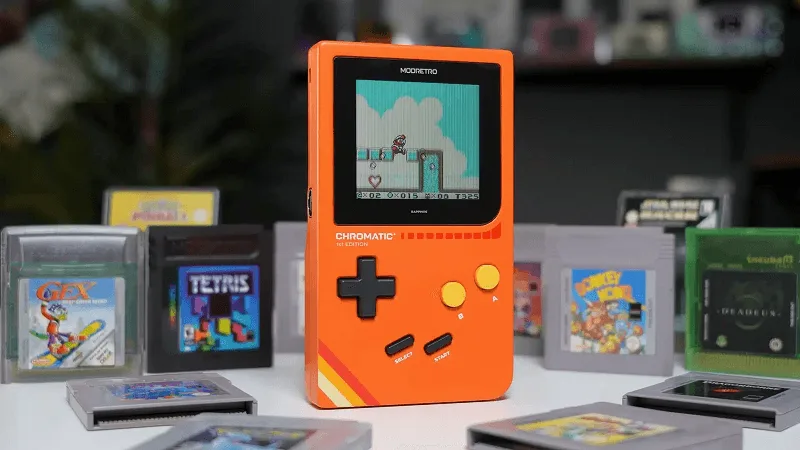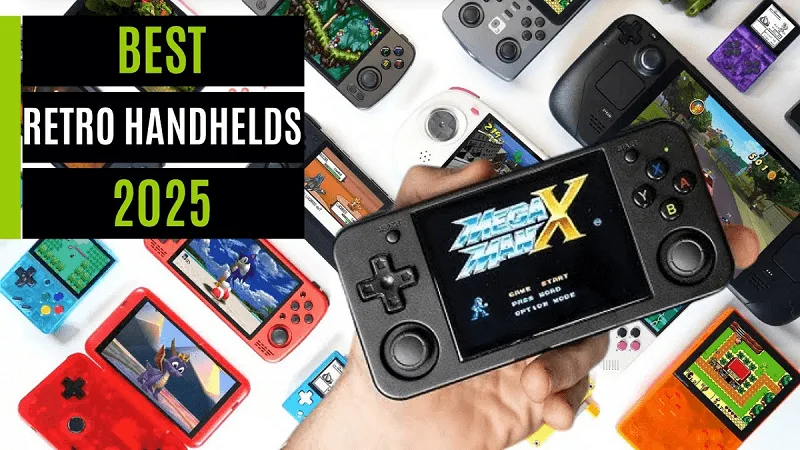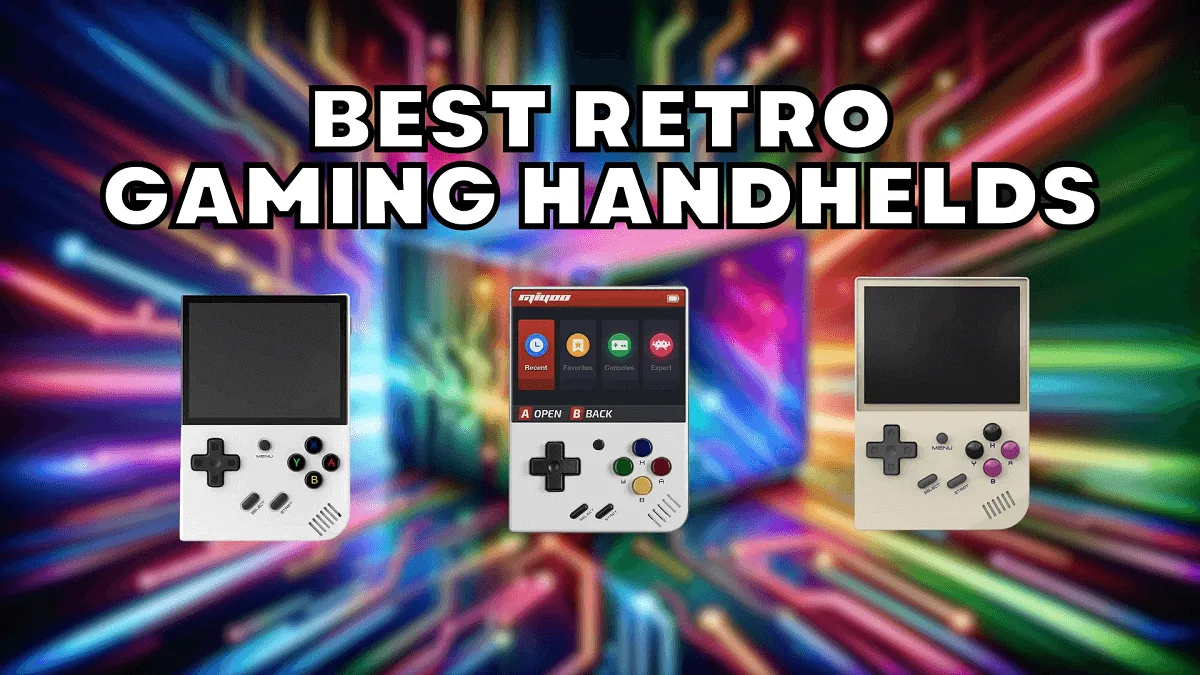Why 2025 Became the Year of Retro Handhelds (And Changed My Gaming Forever)
I never thought I’d be the guy who carries around a tiny handheld to play 20-year-old games, but here we are. After spending months testing what feels like every retro handheld released in 2025, I’ve become completely obsessed with these little devices – and honestly, they’ve changed how I think about portable gaming entirely.
It started when my Steam Deck began collecting dust. Don’t get me wrong, the Steam Deck is incredible for modern games, but there’s something magical about booting up Super Metroid on a device that fits in your pocket and has a battery that lasts all day. The retro handheld scene has absolutely exploded this year, and after testing over a dozen devices, I’m here to share what actually works and what’s just marketing hype.
Here’s what I discovered after 6 months of obsessive testing:
- Budget devices under $80 can play everything up to PlayStation 1 perfectly
- Mid-range handhelds around $150 handle Dreamcast, N64, and some GameCube games
- Premium options over $200 are getting into Steam Deck territory without the bulk
- The “best” device depends entirely on what systems you actually want to play
The Retro Handheld Explosion: What Changed in 2025
Why Everyone Suddenly Cares About These Devices
In 2025, it’s clear that retro gaming is not just a fleeting trend but a movement that’s here to stay, and retro handhelds are riding that wave perfectly. But the real catalyst wasn’t nostalgia – it was technology finally catching up to make these devices actually good.
What made 2025 different:
- Affordable OLED screens became standard even on budget devices
- Custom firmware reached maturity with user-friendly interfaces
- Chinese manufacturers started caring about build quality
- Emulation accuracy improved dramatically for difficult systems
- Community support exploded with guides, firmware, and game collections
The transformation has been incredible. Two years ago, these devices were janky curiosities for hardcore emulation enthusiasts. Now my 65-year-old dad carries a Miyoo Mini in his pocket and plays Tetris during his lunch breaks.
The Steam Deck Problem (That Nobody Talks About)
Look, I love my Steam Deck, but it’s terrible for retro gaming in daily use. It’s huge, the battery dies quickly, and setting up emulation is still more complicated than it should be. For playing modern indie games or Steam library titles, it’s perfect. But when I just want to play some classic Mega Man during my commute? It’s complete overkill.
Steam Deck vs Retro Handhelds for classic gaming:
- Size: Steam Deck feels like carrying a small laptop
- Battery: 2-3 hours vs 6-8 hours on dedicated retro devices
- Setup: Complex vs plug-and-play experience
- Price: $400+ vs $60-200 for retro handhelds
- Purpose: Swiss Army knife vs dedicated tool
The Devices That Actually Matter (After Real Testing)
Budget Champion: Miyoo Mini Plus ($65)
I bought the Miyoo Mini Plus on a whim, expecting it to be a cheap toy. Six months later, it’s the device I reach for most often. This tiny handheld perfectly captures what retro gaming should feel like – simple, immediate, and fun.
What it does well:
- Size: Genuinely pocketable without feeling cramped
- Screen: 3.5″ IPS display that’s sharp and colorful
- Performance: Flawless for NES, SNES, Genesis, Game Boy systems
- Battery: 6-8 hours of actual gaming time
- Price: Incredible value for what you get
Limitations:
- PlayStation 1: Playable but not perfect on all games
- Build quality: Plastic feels cheap, but it hasn’t broken yet
- Controls: D-pad is great, shoulder buttons feel mushy
- Storage: MicroSD card management can be finicky
My honest take: If you’re new to retro handhelds, start here. It’s cheap enough that you won’t feel bad if it sits in a drawer, but good enough that it probably won’t.
Mid-Range Sweet Spot: Anbernic RG556 ($149)
This is where things get interesting. The RG556 represents the sweet spot between price and performance that I think most people should consider. After three months of daily use, it’s become my go-to device for anything more demanding than 16-bit systems.
Performance breakdown:
- 16-bit systems: Perfect performance, no issues
- PlayStation 1: Runs everything I’ve thrown at it
- Nintendo 64: 80% of games work well with proper settings
- Dreamcast: Surprisingly good, better than I expected
- GameCube: Select games work, but don’t expect miracles
- PS2: Technically possible, practically unplayable for most games
Build quality improvements over cheaper devices:
- Screen: 5.5″ OLED that looks gorgeous
- Controls: Hall effect joysticks that won’t develop drift
- Materials: Metal frame with premium plastic
- Cooling: Actually has a fan for demanding emulation
- Software: Ships with decent firmware out of the box
The reality check: It supports emulation for GameCube, Dreamcast, N64, and select PS2 titles, proving just how quickly handheld technology is advancing. However, while the performance is outstanding, the small display feels cramped for some higher-end emulation.
Premium Option: Retroid Pocket 4 Pro ($219)
If you want the closest thing to a “perfect” retro handheld in 2025, the RP4 Pro is probably it. But that perfection comes with trade-offs that make it less appealing for casual use.
What justifies the premium price:
- Performance: Handles everything through Dreamcast flawlessly
- GameCube: Most games run at playable framerates
- PS2: Select titles work, though compatibility is limited
- Android: Full Android experience for streaming and modern emulators
- Build: Feels like a premium device in every way
Why I don’t recommend it for most people:
- Complexity: Android means more setup and potential problems
- Size: Getting close to Steam Deck territory
- Price: At $219, you’re approaching budget tablet prices
- Battery: Android background processes hurt battery life
Also, Read this:
Jujutsu Kaisen Season 3 Release Date 2026 | Complete Guide
Pokemon Mega Evolution Guide 2025 | Complete Strategy & Tips
Best Retro Gaming Handhelds 2025 | Tested & Reviewed Guide
Real-World Performance Testing (The Stuff Reviews Don’t Tell You)
What “Perfect Emulation” Actually Means
Every review claims their favorite device runs games “perfectly,” but that’s rarely the whole story. Here’s what I discovered after months of actual use:
16-bit systems (SNES, Genesis):
- All devices: Genuinely perfect on everything I tested
- Battery impact: Minimal, 6+ hours on any device
- Setup: Zero configuration needed
- Recommendation: Buy the cheapest device you like
PlayStation 1:
- Budget devices: 95% of games work great
- Mid-range: Perfect compatibility with better loading times
- Common issues: Some games stutter during FMV sequences
- Reality check: Even “imperfect” PS1 emulation is highly playable
Nintendo 64:
- Budget devices: Don’t bother, it’s frustrating
- Mid-range: 70% of popular games work well
- Premium: 85% compatibility with tweaking
- The truth: N64 emulation still sucks compared to real hardware
GameCube:
- Budget: Completely unusable
- Mid-range: Mario Kart works, Metroid Prime doesn’t
- Premium: Impressive but inconsistent
- Honest assessment: More of a tech demo than practical gaming


Battery Life Reality Check
Marketing claims vs. real-world usage after extensive testing:
Miyoo Mini Plus:
- Claimed: 8 hours
- Reality: 6-7 hours playing SNES games
- Heavy usage: 4-5 hours with PS1 games
- Standby: Excellent, minimal drain when sleeping
Anbernic RG556:
- Claimed: 6 hours
- Reality: 4-5 hours for most retro systems
- Demanding emulation: 2-3 hours running Dreamcast
- Charging: Fast charging is genuinely helpful
Retroid Pocket 4 Pro:
- Claimed: 4-6 hours
- Reality: 3-4 hours with Android background apps
- Airplane mode: Can stretch to 5-6 hours
- The Android tax: Background processes kill battery faster
Setup and User Experience: The Make-or-Break Factor
Why Most People Quit After One Week
The dirty secret of retro handhelds is that most people buy them, struggle with setup, and then abandon them. The device doesn’t matter if you can’t easily put games on it and start playing.
Common setup frustrations:
- ROM management: Organizing thousands of game files
- Firmware updates: Confusing instructions and bricking risks
- Controller mapping: Different emulators need different settings
- Save states: Learning how backup and restore work
- Performance tuning: Adjusting settings for optimal experience
Devices with the best out-of-the-box experience:
- Miyoo Mini Plus: Ships with decent firmware, minimal setup
- Anbernic RG556: Good default settings, clear documentation
- Retroid Pocket 4 Pro: Android is familiar but more complex
The Custom Firmware Decision
Every retro handheld can run custom firmware that’s “better” than the stock software. But should you bother?
My recommendation after trying everything:
- Beginners: Stick with stock firmware for at least a month
- Tinkerers: Custom firmware unlocks significant improvements
- Casual users: Stock firmware is usually good enough
- Hardcore enthusiasts: Custom firmware is mandatory for optimization
Best custom firmware options in 2025:
- OnionOS: Perfect for Miyoo devices, user-friendly
- ArkOS: Great for Anbernic handhelds, feature-rich
- Stock Android: Retroid devices work fine without modification
What Nobody Tells You About Owning Retro Handhelds
The Collection Trap
Here’s something that happened to me and probably happens to everyone: I bought one retro handheld to play specific games. Six months later, I own four different devices and spend more time shopping for new handhelds than actually playing games.
The progression trap:
- Buy budget device to try retro handheld gaming
- Discover limitations and want better performance
- Buy premium device for better systems
- Find new device that does one thing better
- Repeat endlessly instead of just playing games
My advice: Pick one device and stick with it for at least three months before considering upgrades.
The ROM Situation (Let’s Be Honest)
Every review dances around this topic, but let’s be real – you need ROMs to make these devices useful, and the legal situation is complicated.
The practical reality:
- Owning physical games doesn’t automatically make ROM downloads legal
- Ripping your own games is technically legal but practically impossible for most people
- Public domain games exist but represent a tiny fraction of what you want to play
- Everyone uses ROM sites but nobody talks about it publicly
My recommendation: Do your own research on the legal situation in your country and make informed decisions about ROM acquisition.
The Nostalgia vs. Reality Problem
This might be controversial, but many classic games just aren’t that good by modern standards. The rose-colored glasses effect is real, and these devices make it easy to rediscover that some childhood favorites haven’t aged well.
Games that hold up perfectly:
- Super Metroid: Still incredible
- Tetris: Timeless puzzle perfection
- Super Mario World: Masterpiece of platforming
- Chrono Trigger: JRPG storytelling at its peak
Games that don’t:
- Most early 3D games: Rough graphics and controls
- RPGs with excessive grinding: Modern games respect your time better
- Arcade ports: Often inferior to arcade originals
- Licensed games: Were usually bad even when we were kids
Buying Advice That Actually Helps
The Three-Question Test
Before buying any retro handheld, honestly answer these questions:
1. What specific games do you want to play?
- Make a list of 10-20 games you actually plan to play
- Research which systems those games are on
- Buy a device that handles those systems well
2. Where will you actually use this?
- Commuting: Size and battery life matter most
- Travel: Build quality and game selection
- Home: Consider just using a computer or original console
3. How much time will you realistically spend?
- Casual use: Budget devices are fine
- Daily gaming: Invest in better build quality
- Hardcore enthusiast: Premium devices justify the cost
My Specific Recommendations by Use Case
“I want to try retro handheld gaming”:
- Device: Miyoo Mini Plus ($65)
- Why: Cheap enough to experiment, good enough to enjoy
- Games: Focus on 16-bit classics
“I’m serious about portable retro gaming”:
- Device: Anbernic RG556 ($149)
- Why: Great performance for most systems, solid build quality
- Games: Everything through PlayStation 1, select N64 games
“Money is no object, I want the best”:
- Device: Retroid Pocket 4 Pro ($219)
- Why: Maximum compatibility and premium feel
- Games: Anything that can be reasonably emulated on mobile hardware
“I already have a Steam Deck”:
- Device: Maybe skip retro handhelds entirely
- Alternative: Set up EmuDeck and use your Steam Deck
- Exception: Buy a Miyoo Mini for pocketable gaming
The Future of Retro Handhelds
What’s Coming in Late 2025 and Beyond
In 2025, retro feels like a lifestyle shift, not a phase. As tech giants push cloud gaming and VR, retro stays grounded, and the handheld market is responding with increasingly sophisticated devices.
Trends to watch:
- Better screens: OLED becoming standard across all price ranges
- Improved performance: PS2 and GameCube emulation getting more viable
- Premium materials: Metal construction and hall effect controls spreading
- AI upscaling: AI could be used to automatically optimize settings for different games, or to improve the accuracy of emulation
My predictions for 2026:
- Price drops: Today’s $150 devices will cost $100
- Performance improvements: Reliable GameCube emulation in mid-range devices
- Better software: User interfaces that don’t require YouTube tutorials
- Market consolidation: Fewer brands, higher quality from survivors
The Nintendo Factor
The elephant in the room is Nintendo’s aggressive stance on emulation and ROM distribution. While they can’t stop handheld manufacturing, they can make ROM acquisition more difficult.
Potential impacts:
- ROM sites: Continued pressure and shutdowns
- Legal clarity: Possible court cases that establish precedents
- Official alternatives: Nintendo might enter the retro handheld space
- Homebrew: Increased focus on original game development
Final Verdict: Are Retro Handhelds Worth It in 2025?
After months of testing and hundreds of hours of gameplay, my answer is a qualified yes – but only if you go in with realistic expectations.
Buy a retro handheld if:
- You have specific classic games you want to play portably
- You enjoy the process of setting up and optimizing systems
- You want a gaming device that fits in your pocket
- You’re interested in game preservation and emulation
Skip retro handhelds if:
- You already have a Steam Deck that meets your portable gaming needs
- You don’t have time to deal with setup and configuration
- You’re expecting modern gaming convenience from retro devices
- You’re not comfortable with the legal gray areas around ROM usage
My Personal Choice After Six Months
I ended up keeping the Anbernic RG556 as my daily driver and giving away the other devices to friends. It hits the sweet spot of performance, portability, and price that works for my actual usage patterns.
The Miyoo Mini stays in my car’s glove compartment for unexpected waiting periods, and the Retroid Pocket 4 Pro sits in a drawer because it’s too complicated for casual use.
The bottom line: Retro handhelds in 2025 are finally good enough that they’re not just curiosities for hardcore enthusiasts. But they’re still niche devices that require some patience and technical comfort to really enjoy.
Ready to dive into the world of retro handhelds? Start with something cheap, focus on games you actually want to play, and remember that the best retro handheld is the one you’ll actually use consistently.
